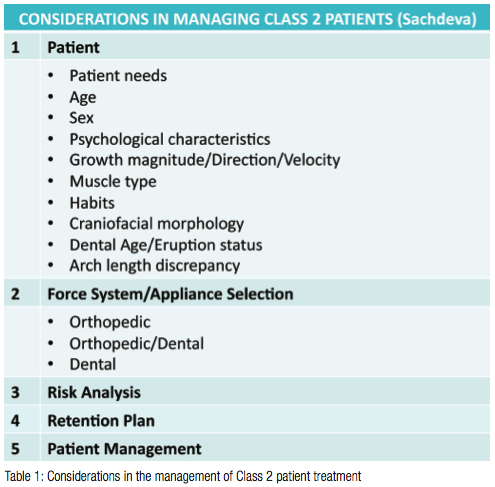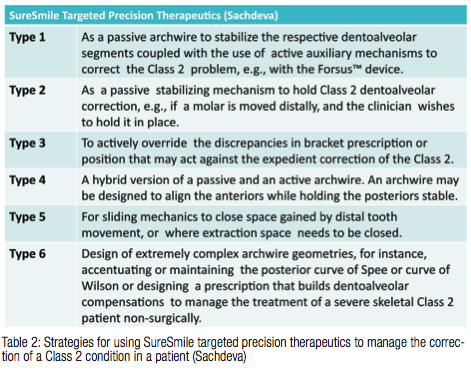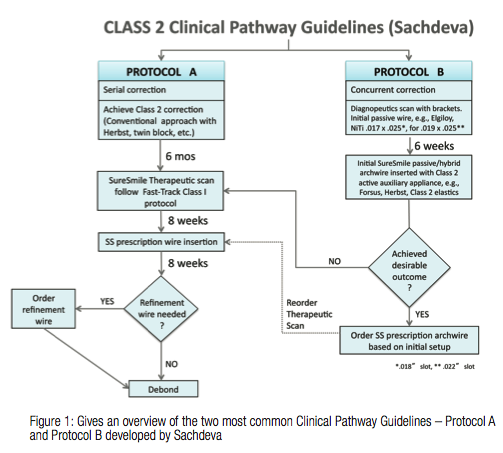
Drs. Rohit C.L. Sachdeva, Steve Moravec, and Takao Kubota discuss the application of SureSmile® technology in the management of patients presenting with Class 2 malocclusions
Introduction
The Class 2 malocclusion does not simply manifest itself as a sagittal problem of the craniofacial complex.
[userloggedin]
Its etiology and manifestation is a result of a blending of a complex of elements that also have a temporal and functional component. Careful dissection, planning, and manage-ment of the contributing factors, and the three-dimensional recognition of the morphological and spatial components of the presenting malocclusion play a significant role in the efficient and effective care of these patients. Table 1 provides a list of high-level factors that need to be considered in formulating a plan of care for a Class 2 patient.

The focus of this paper is limited to discussing the application of SureSmile® technology1-10 in the management of patients presenting with Class 2 malocclusions by discussing specific patient histories.
II. Application of SureSmile in treatment of patients with Class 2 malocclusion
In general, SureSmile technology provides five major functionalities in aiding the orthodontist in managing the care of Class 2 patients (Sachdeva). These are:
A. Decision support with 3D simulations
These simulations provide a visual interface for the orthodontist to understand the severity of the presenting a problem in 3D. Furthermore, it augments the doctor’s ability to plan the nature of Class 2 correction. This may be orthopedic and or dentoalveolar in nature. The magnitude of the correction designed in the simulation is based upon the doctor’s mental model, reality, research findings, patient’s expectations, and expected participation in care, and also the doctor’s skills. Recognition of the contributory factors that potentially aid in the correction of the malocclusion and the directionality of their displacement supports the clinician’s decision in selecting and designing the appropriate appliance and therapeutic approach in managing care. Additionally, various treatment scenarios may be planned, and the optimal design selected.
B. Communication
The visual interface provides an extremely valuable and persuasive approach to enhance the learning experience of the patient with regard to her affliction and also discusses the virtual plan in an interprofessional environment.
C. Patient management
The visual plan also provides the patient, the doctor, and the staff with a useful approach to track and manage the progress of patient care and, most importantly, to motivate the patient through the course of care.
D. Targeted precision therapeutics
SureSmile targeted precision appliances may be used in six different ways (Sachdeva) (Table 2) to manage the correction of the Class 2 malocclusion.

E. Outcome evaluation
SureSmile visual tools may also be used very effectively to measure treatment outcome and implement the findings into a continuous quality improvement initiative in the practice.
II. Clinical Pathway Guidelines for managing patients with
Class 2 malocclusion
Effective use of SureSmile technology mandates the management of a patient by following processes that are defined by Clinical Pathway Guidelines (CPG). Exceptions to CPG occur to suit individual’s needs; however, in most situations, they provide a reasonable approach to navigate the care of a patient in a systematic and progressive manner.
Common to all Clinical Pathway Guidelines (CPG) to manage patients with Class 2 malocclusion is the use of the decision support system to plan care at the onset of treatment. The type and timing in use of SureSmile precision archwires varies and is driven by the dictates of the plan (Figure 1).
Class 2 Clinical Pathway Guidelines (Sachdeva) broadly fall under two categories: namely, a Protocol A and Protocol B. These are shown in Figure 1.

III. Patient SK history —
Protocol A
The following is a description of the management of a patient presenting with a Class 2 Div 1 Subdivision right using Protocol A. Patient SK presented as a 12-year-old male pre-peak velocity. The initial records of the patient are shown in Figure 4.
The SureSmile decision support system was used to design a 3D treatment plan for the patient. The plan, as shown in Figure 5, considered both orthopedic and dentoalveolar displacements. Figure 6 shows a close-up view of the midline correction and the archwidth changes as a result of both orthopedic and dentoalveolar movements. In deciding the amount of archwidth changes, one needs to consider the buccolingual axial inclinations of the molar and premolars in the buccal segments shown in Figure 7. An additional aspect in planning the care for patient SK involved developing incremental milestones to evaluate the progress of care as shown in Figure 8.
The initial treatment of the patient began with the use of a unilateral Forsus™ appliance on the patient’s right side on a near full sized .017” x .025”, Af 27ºC NiTi both in the upper and lower arch with a .018” bracket. The Class 2 correction was achieved over a period of 7 months. At this time, records were taken to initiate the SureSmile process (Figure 9). The patient was scanned for the Virtual Therapeutic Model (VTM), and a Virtual Therapeutic Setup (VTS) was designed (Figure 10). Both upper and lower .017” x .025”, Af 35ºC NiTi SureSmile prescriptive archwires were installed 8-weeks post Therapeutic scan and backed up with light Class 2 elastic wear. (The wire should have been installed a month earlier, but this was not possible because the patient missed an appointment.) The SureSmile active treatment phase lasted 3 months, and the patient was debonded 4 months from the initial installation of the SureSmile archwires.
An outcome evaluation for the patient was performed by superimposing the models representing different stages shown in Figures 12 and 13.
Conclusions
Effective management of Class 2 correction requires careful planning and execution. SureSmile technology provides a valuable technology platform to extend the skill sets of an orthodontist to accomplish these goals. Future papers will discuss a spectrum of patient histories showing the versatility of using SureSmile technology in treating patients with Class 2 malocclusions governed by the philosophy and principles of BioDigital Orthodontics.
Acknowledgments
The authors thank both Dr. Sharan Aranha and Maya Sachdeva for the preparation of this manuscript. The authors are also grateful to Peter Kierl, DDS, MS, Ortho (Edmond, Oklahoma); and Darrell Schmidt, DDS, MS, Ortho (Rhinelander, Wisconsin) for sharing some of their patient records.
References
1.White L, Sachdeva R. Transforming orthodontics-Part 1 of a conversation with Dr. Rohit Sachdeva, Co-founder and Chief Clinical Officer of Orametrix Inc. by Dr. Larry White. Orthodontic Practice US. 2012;3(1):10-14.
2.White L, Sachdeva R. Transforming orthodontics-Part 2 of a conversation with Dr. Rohit Sachdeva, Co-founder and Chief Clinical Officer of Orametrix Inc. by Dr. Larry White. Orthodontic Practice US. 2012;3(2):6-10.
3.White L, Sachdeva R. Transforming orthodontics-Part 3 of a conversation with Dr. Rohit Sachdeva, Co-founder and Chief Clinical Officer of Orametrix Inc. by Dr. Larry White. Orthodontic Practice US. 2012;3(3):6-9.
4.Sachdeva R. BioDigital orthodontics: Management of Class 1 non–extraction patient with “Fast–Track”©– six month protocol: Part 5. Orthodontic Practice US. 2013;4(5):18-27.
5.Sachdeva R, Kubota T, Hayashi K. BioDigital orthodontics: Management of Class 1 non–extraction patient “Standard–Track”©– nine month protocol: Part 6. Orthodontic Practice US. 2013;4(6):16-26.
6.Sachdeva R, Kubota T, Hayashi K. BioDigital orthodontics: Management of space closure in Class I extraction patients with SureSmile: Part 7. Orthodontic Practice US. 2014;5(1):14-23.
7.Sachdeva R. BioDigital orthodontics: Designing customized therapeutics and managing patient treatment with SureSmile technology: part 2. Orthodontic Practice US. 2013;4(2):18-26.
8. Sachdeva R. BioDigital orthodontics: Diagnopeutics with SureSmile technology: part 3. Orthodontic Practice US. 2013;4(3). 2013;4(3):22-30.
9.Sachdeva R. BioDigital orthodontics: Outcome evaluation with SureSmile technology: Part 4. Orthodontic Practice US. 2013;4(4):28-33.
10.Sachdeva R. BioDigital orthodontics: Planning care with SureSmile Technology: Part 1. Orthodontic Practice US. 2013;4(1):18-23.
Gallery
{gallery}140322_Sachdeva{/gallery}
Stay Relevant With Orthodontic Practice US
Join our email list for CE courses and webinars, articles and mores


